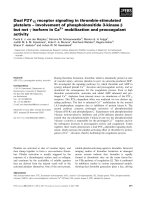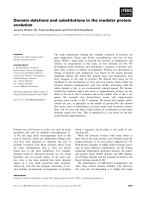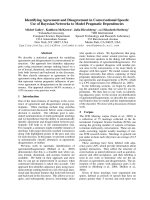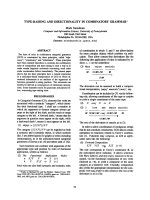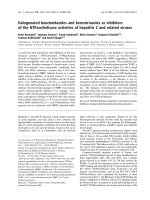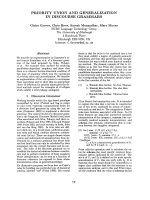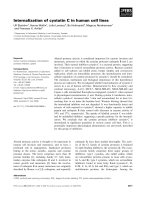Báo cáo khoa học:" Hepatitis B and C in dialysis units in Kosova" pps
Bạn đang xem bản rút gọn của tài liệu. Xem và tải ngay bản đầy đủ của tài liệu tại đây (328.49 KB, 4 trang )
BioMed Central
Page 1 of 4
(page number not for citation purposes)
Virology Journal
Open Access
Research
Hepatitis B and C in dialysis units in Kosova
Skender Telaku*
1
, Hajrullah Fejza
2
, Ymer Elezi
3
and Teuta Bicaj
4
Address:
1
Gastroenterology Unit, University Clinical Center of Kosova, Prishtina, Republic of Kosova,
2
Sector for Public Health, Municipality of
Prishtina, Republic of Kosova,
3
Nephrology Unit, University Clinical Center of Kosova, Prishtina, Republic of Kosova and
4
Department for
Prosthetics Dentistry, University Dentistry Clinical Center of Kosova, Prishtina, Republic of Kosova
Email: Skender Telaku* - ; Hajrullah Fejza - ; Ymer Elezi - ;
Teuta Bicaj -
* Corresponding author
Abstract
Background: Hepatitis B virus (HBV) and hepatitis C virus (HCV) infections are important causes
of morbidity and mortality of hemodialysis (HD) patients. This study aimed to investigate the
epidemiological and clinical features of HCV and HBV infections in six different HD units in Kosova.
Five hundred and eighty-three end-stage kidney disease (ESKD) patients on maintenance HD from
six HD centers in Kosova (358 female, 225 male, mean age 54,8 years (16–66) were included in this
study. Data from databank of the National Blood Bank in Prishtina, as well as the data from the
databank of the Transfusion Centers in Regional hospitals in Prizren, Peja, Gjilan, Mitrovica and
Gjakova were taken in this study. Clinical data such as age, sex, HBsAg and anti-HCV antibody and
primary causes of ESKD were examined.
Serological markers for HBV and HCV were determined with immunoenzymatic assay (ELISA).
Results: The T-test and x
2
test were used to analyze the significance of the results. Among our
HD patients HBsAg and anti-HCV antibody prevalence rate was 12%, respectively 43%. Chronic
nephritis was a more frequent cause of ESKD among our HD patients. With unknown etiology
were 23, 5% from them.
Conclusion: HBV and HCV prevalence in our HD patients is still high. These data emphasize the
need for stricter adherence to infection control, barrier precaution and preventive behaviors with
all patients.
Background
Hemodialysis (HD) patients are at high risk for viral hep-
atitis infections due to the high number of blood transfu-
sion sessions, prolonged vascular access and the potential
for exposure to infected patients and contaminated equip-
ment [1,2].
The prevalence of HCV antibodies in nephrology units is
high and has been reported to range from 5 to 54% [3].
HBV infection is less prevalent than HCV in HD units [4].
The rate of serum HBsAg seropositivity on maintenance
HD in the developed world is currently low (0–10%) but
outbreaks of acute HBV infection continue to occur in this
setting. The prevalence of HBV infection within dialysis
units in developing countries appears higher (2–20%)
based on relatively several reports [5].
Published: 4 June 2009
Virology Journal 2009, 6:72 doi:10.1186/1743-422X-6-72
Received: 16 April 2009
Accepted: 4 June 2009
This article is available from: />© 2009 Telaku et al; licensee BioMed Central Ltd.
This is an Open Access article distributed under the terms of the Creative Commons Attribution License ( />),
which permits unrestricted use, distribution, and reproduction in any medium, provided the original work is properly cited.
Virology Journal 2009, 6:72 />Page 2 of 4
(page number not for citation purposes)
The aim of the present study was to investigate the epide-
miological and clinical features of HCV and HBV infec-
tions in six different HD units in Kosova.
Methods
Clinical and epidemiological data were obtained from
January to December 2008 in six different HD units in
Kosova (Prishtina with 150, Prizren with 110, Peja with
74, Gjilani 80, Mitrovica 71 and Gjakova with 31
patients). Data from databank of the National Blood Bank
in Prishtina as well the data from the above mentioned
transfusion centers were used in this study. Clinical data
such as age, sex, HBsAg and anti-HCV antibody and pri-
mary cause of ESKD were examined.
Serological testing for HBV surface antigen and antibodies
to HCV was performed using microparticle enzyme
immunoassay (Abbott AxSM System, Abbott Laborato-
ries, Abbott Park, Illinois, USA) and appropriate assays
manufactured for the system (Abbott-AxSYM HBsAg ver-
sion 2 and HCV version 3.0 assays). The T-test and x
2
test
were used to analyze the significance of the results.
Results
From 583 patients, 358 (61,4%) of them were female and
225(38,6%) were male, and the age ranged from 16–66
years with mean age 54.8 years, (Table 1).
The major primary renal diseases in the end stage of kid-
ney disease (ESKD) patients included chronic nephritis
(23, 2%), diabetes mellitus (19,2%), hypertension
(13,2%), urologic diseases (7,3%), cystic renal diseases
(6,1%), and nonspecific chronic pyelonephritis (6%).
Four patients (0, 7%)were with systemic lupus erytemath-
osus (SLE). There were 23, 5% (137 patients) with
unknown etiology, (Figure 1).
More than 80% of patients were between age 26 and 65
years old whereas only 7.5% of them were younger than
25 year, (Figure 2).
In this study, 70 patients (12%) were HBsAg positive, and
250 of them (43%) were anti HCV positive, (Figure 3).
Disccusion
In patients on maintenance HD, the risk of hepatitis is still
a serious problem despite the availability of serological
tests and vaccines for hepatitis B virus infection and uni-
versal precaution standards and infection control meas-
ures. Available data suggest that HCV has become the
most common cause of acute hepatitis in dialysis patients
and dialysis staff members, following the implementation
of infection control measures for HBV, [6].
In our study, the prevalence of HBsAg was 12%.
Results of the examination which were done with 165 HD
patients from three units in Kosova (Prishtina, Prizren
and Mitrovica) during first six months of 2003 showed
that prevalence of anti HCV antibodies and HBsAg were
38.78%, respectively 24,24%. This study showed that
duration of dialysis and number of transfusions are risk
factors for development of HBV and HCV infection (p < 0,
05) [7].
Table 1: The number and sex of tested patients in Hemodialysis
Unit
Sex N %
M22538.6
F35861.4
Total 583 100
Etiology of prevalent regular HD patientsFigure 1
Etiology of prevalent regular HD patients.
Age distribution of prevalent regular HD patientsFigure 2
Age distribution of prevalent regular HD patients.
Virology Journal 2009, 6:72 />Page 3 of 4
(page number not for citation purposes)
The results of our last study demonstrate a decrease in
prevalence of HBV positive HD patients during from 24,
24% to 12% over six years. This decrease of HBV infection
in dialysis patients over the years despite implementation
of universal precaution is a result of advent of recom-
binant human erythropoietin and HBV vaccination in last
years. This prevalence is higher than in USA, Croatia,
Japan, Casablanca, Iran, Jordan, Kenya, Saudi Arabia,
Hong Kong and lower than India, Taiwan, Romania,
Greece, Spain, Turkey and Brazil [8-23].
The HBV prevalence among the blood donors of Kosova
is 4, 2%, which range Kosova to the second zone accord-
ing to the CDC classification of the geographical expand-
ing of the HBV infection. The HCV prevalence among the
blood donors in Kosova is 0,3%, compared to other Euro-
pean countries this level of prevalence is relatively low
[24].
Results of the study which were done with Kosovar refu-
gees who had arrived in southern Italy in 1999 revealed
that HBV infection seems to be at an intermediate level of
endemicity. At the same time this study indicates that the
level of endemicity of HCV infection in Kosovar popula-
tion is low [25].
HCV prevalence in HD varies geographically, both within
and between countries [26].
The reported anti-HCV seropositivity since 1999 ranges
from low (1.9%) in the Slovenia [27] to high (80%) in
Senegal [28]. HCV seroprevalence in the HD population
was 59% in Bosnia and Herzegovina, 6.8% in Belgium,
16.3% in France, 6.1% in Germany, 10%–29% in Greece,
22.5%–32.1% in Italy, 75% in Moldavia, 3.4% in the
Netherlands, 11% in Sweden, 7%–23.3% in the USA, 4%
in the UK, 20.5% in Libya, 71% in Kuwait, 23.7% in
Sudan, 19% – 41.7% in Tunisia, 8.4%–43.2% in Brazil,
6.7% in Mexico, 59.3% in Peru, 3.5% in Puerto Rico and
13.2% in Iran [29-47]
The prevalence of HCV among our HD patients is 43%,
compared with above mentioned study [7] there is not a
decrease in prevalence of HCV in our HD patients over
last six years. In our opinion environment condition in
our hemodialysis units are responsible for high preva-
lence of HCV in our HD patients.
Conclusion
In summary, the prevalence of HBV and HCV in our HD
patients is still high. These data emphasize the need for
stricter adherence to infection control, barrier precaution
and preventive behaviors with all patients.
Competing interests
The authors declare that they have no competing interests.
Authors' contributions
ST participated in the design of the study, comparing the
results with other publications and drafted manuscript.
HF participated in design of the study and performed the
statistical analysis. YE carried about data collecting. TB
participated in additional correction and design.
All authors have read and approved the final manuscript.
References
1. Meyers CM, Seef LB, Stehman-Breen CO, Hoofnagle JH: Hepatitis
C and renal disease: an update. Am J Kidney Dis 2003,
42(4):631-657.
2. Fabrizi F, de Vecchi AF, Como G, Lunghi G, Martin P: De novo HCV
infection among dialysis patients: a prospective study by
HCV core antigen ELISA assay. Aliment Pharmacol Ther 2005,
21(7):861-869.
3. Wright TL, Pereira BJG: Hepatitis C virus: a threat without a
cure to the patient with ESRD. Semin Dial 1997, 10(5):241-247.
4. Oesterreicher C, Muller C: HBV and HCV genome in peripheral
blood mononuclear cells in patients undergoing chronic
hemodialysis. Kidney international 1995, 48:1967-1971.
5. Fabrizi F, Messa P, Martin P: Hepatitis B virus infection and the
dialysis patient. Semin Dial 2008, 21(5):440-446.
6. Niu MT, Coleman PJ, Alter MJ: Multicenter study of hepatitis C
virus infection in chronic hemodialysis patients and hemodi-
alysis staff members. Am J Kidney Dis 1993, 22(4):568-573.
7. Telaku S, Zekaj S, Avdijaj Xh, Elezi Y, Kuqi Xh, Zylfiu B, Rudhani I,
Hasanxhekaj V, Fejza H: Prevalence of hepatitis B and C infec-
tion in dialysis patient in Kosova. The Turkish Journal of Gastroen-
terology 2003, 14(Suppl 1):106.
8. Tokars JI, Finelli L, Alter MJ, Arduino MJ: National surveillance of
dialysis-associated diseases in the United States 2001. Semin
Dial 2004, 17(4):310-319.
9. Kes P, Slavicek J, Jankovic N: Prevention and treatment of hepa-
titis B in patients on hemodialysis and vaccination of hemo-
dialysis health personnel against hepatitis B. Acta Med Croatica
2005, 59(5):479-482.
10. Oguchi H, Miyasaka M, Tokunaga S: Hepatitis virus infection
(HBV and HCV) in eleven Japanese hemodialysis units. Clin
Nephrol 1992, 38(1):36-43.
HBV and HCV of prevalent regular patients HD patientsFigure 3
HBV and HCV of prevalent regular patients HD
patients.
Virology Journal 2009, 6:72 />Page 4 of 4
(page number not for citation purposes)
11. Boulaajaj K, Elomari Y, Elmaliki B: Prevalence of hepatitis C, hep-
atitis B and HIV infection among haemodialysis patients in
Ibn-Rochd university hospital, Casablanca. Nephrol Ther 2005,
1(5):274-284.
12. Taremi M, Khoshbaten M, Gachkar L, EhsaniArdakani M, Zali M:
Hepatitis E virus infection in hemodialysis patients: A
seroepidemiological survey in Iran. BMC Infect Dis 2005,
5(1):36-38.
13. Munter H, Yousef A: Hepatitis B infection among Patients
Receiving Chronic Hemodialysis at Royal Medical Services in
Jordan. Saudi J Kidney Dis Transpl 2008, 19(2):260-267.
14. Otedo AE, Mc'Ligeyo SO, Okoth FA: Seroprevalence of hepatitis
B and C in maintenance dialysis in a public hospital in a
developing country. S Afr Med J 2003, 93(5):380-384.
15. Khan LA, Khan SA: Prevalence of Hepatitis B and C markers in
patients on maintenance hemodialysis in Najran. Saudi Med J
2001, 22(7):641-642.
16. Leung CB, Ho YW, Chau KF, Choy BY, Tsang WK, Lui SF: Renal
replacement therapy for chronic hepatitis B carrier: A sub-
group analysis from the Hong Kong Renal Registry 1995–
1999. Hong Kong J Nephrol 2000, 2:104-109.
17. Chattopadhyay S, Rao S, Das BC: Prevalence of transfusion-
transmitted virus infection in patients on maintenance
hemodialysis from New Delhi, India. Hemodial Int 2005,
9(4):362-366.
18. Chen KS, Lo SK, Lee N, Leu ML, Huang CC, Fang KM: Superinfec-
tion with hepatitis C virus in hemodialysis patients with hep-
atitis B surface antigenemia: Its prevalence and clinical
significance in Taiwan. Nephron 1996, 73(2):158-164.
19. Covic A, Iancu L, Apetrei C: Hepatitis virus infection in haemo-
dialysis patients from Moldavia. Nephrol Dial Transplant 1999,
14(1):40-45.
20. Siagris D, Christofidou M, Triga K: Occult hepatitis B virus infec-
tion in hemodialysis patients with chronic HCV infection. J
Nephrol 2006, 19(3):327-333.
21. Loza Munarriz C, Depaz Dolores M, Jara M: Rate of serological
markers of hepatitis B and C viruses in first-time users of the
hemodialysis program at Hospital Nacional Cayetano Here-
dia (HNCH). Rev Gastroenterol Peru 2005, 25(4):320-327.
22. Yakaryilmaz F, Gurbuz OA, Guliter S: Prevalence of occult hepa-
titis B and hepatitis C virus infections in Turkish hemodialy-
sis patients. Ren Fail 2006, 28(8):729-735.
23. Ferreira RC, Teles SA, Dias MA: Hepatitis B virus infection pro-
file in hemodialysis patients in Central Brazil: Prevalence,
risk factors and genotypes. Mem Inst Oswaldo Cruz 2006,
101(6):689-692.
24. Fejza H, Telaku S: Prevalence of HBV and HCV among blood
donors in Kosova. Virol J 2009, 13:6-21.
25. Chironna M, Germinario C, Lopalco PL, Carrozini F, Quatro M:
Prevalence of hepatitis virus infections in Kosovar refugees.
Int J Infect Dis 2001, 5(4):209-213.
26. Jadoul M, Cornu C, van Ypersele de Strihou C: Universal precau-
tions prevent hepatitis C virus transmission: a 54 month fol-
low-up of the Belgian Multicenter Study. The Universitaires
Cliniques St-Luc (UCL) Collaborative Group. Kidney Int 1998,
53:1022-1025.
27. Buturović-Ponikvar J: Renal replacement therapy in Slovenia:
annual report 2001. Nephrol Dial Transplant 2003, 18(Suppl
5):v53-v55.
28. Diouf ML, Diouf B, Niang A, Ka EH, Pouye A, Seck A, Raphenon G,
Moreira-Diop T: Prevalence of hepatitis B and C viruses in a
chronic hemodialysis center in Dakar. Dakar Med 2000, 45:1-4.
29. Ahmetagić S, Muminhodzić K, Cickusić E, Stojić V, Petrović J, Tihić N:
Hepatitis C infection in risk groups. Bosn J Basic Med Sci 2006,
6:13-17.
30. Jadoul M, Poignet JL, Geddes C, Locatelli F, Medin C, Krajewska M,
Barril G, Scheuermann E, Sonkodi S, Goubau P: The changing epi-
demiology of hepatitis C virus (HCV) infection in haemodial-
ysis. Nephrol Dial Transplant 2004, 19:904-909.
31. Salama G, Rostaing L, Sandres K, Izopet J: Hepatitis C virus infec-
tion in French hemodialysis units: a multicenter study. J Med
Virol 2000, 61:44-51.
32. Hinrichsen H, Leimenstoll G, Stegen G, Schrader H, Fölsch UR,
Schmidt WE: Prevalence and risk factors of hepatitis C virus
infection in haemodialysis patients: a multicentre study in
2796 patients. Gut 2002, 51:429-433.
33. Rigopoulou EI, Stefanidis I, Liaskos C, Zervou EK, Rizos C, Mina P,
Zachou K, Syrganis C, Patsidis E, Kyriakopoulos G, Sdrakas L, Tsianas
N, Dalekos GN: HCV-RNA qualitative assay based on tran-
scription mediated amplification improves the detection of
hepatitis C virus infection in patients on hemodialysis:
results from five hemodialysis units in central Greece. J Clin
Virol 2005, 34:81-85.
34. Lombardi M, Cerrai T, Geatti S, Negroni S, Pertusini L, Pegoraro M,
Di Lullo G: Results of a national epidemiological investigation
of HCV infection in dialysis patients. EDTNA ERCA J 1999,
25:38-42.
35. Covic A, Iancu L, Apetrei C, Scripcaru D, Volovat C, Mititiuc I, Covic
M: Hepatitis virus infection in haemodialysis patients from
Moldavia. Nephrol Dial Transplant 1999, 14:40-45.
36. Schneeberger PM, Keur I, van Loon AM, Mortier D, de Coul KO, van
Haperen AV, Sanna R, van Der Heijden TG, van Den Hoven H, van
Hamersvelt HW, Quint W, van Doorn LJ: The prevalence and
incidence of hepatitis C virus nfections among dialysis
patients in the Netherlands: a nationwide prospective study.
J Infect Dis 2000, 182:1291-1299.
37. Almroth G, Ekermo B, Månsson AS, Svensson G, Widell A: Detec-
tion and prevention of hepatitis C in dialysis patients and
renal transplant recipients. A long-term follow up (1989–Jan-
uary 1997). J Intern Med 2002, 251:119-128.
38. Kalantar-Zadeh K, Kilpatrick RD, McAllister CJ, Miller LG, Daar ES,
Gjertson DW, Kopple JD, Greenland S: Hepatitis C virus and
death risk in hemodialysis patients. J Am Soc Nephrol 2007,
18:
1584-1593.
39. Wreghitt TG: Blood-borne virus infections in dialysis units – a
review. Rev Med Virol 1999, 9:101-109.
40. Daw MA, Elkaber MA, Drah AM, Werfalli MM, Mihat AA, Siala IM:
Prevalence of hepatitis C virus antibodies among different
populations of relative and attributable risk. Saudi Med J 2002,
23:1356-1360.
41. El-Amin HH, Osman EM, Mekki MO, Abderlraheem MB, Ismail MO,
Yousif ME, Abass A, Elhaj HS, Ammar HK: Hepatitis C virus infec-
tion in hemodialysis patients in Sudan:Two centers report.
Saudi J Kidney Dis Transpl. 2007, 18(1):101-106.
42. Bouzgarrou N, Fodha I, Othman SB, Achour A, Grattard F, Trabelsi
A, Pozzetto B: Evaluation of a total core antigen assay for the
diagnosis of hepatitis C virus infection in hemodialysis
patients. J Med Virol 2005, 77:502-508.
43. Lopes EP, Gouveia EC, Albuquerque AC, Sette LH, Mello LA, Moreira
RC, Coelho MR: Determination of the cutoff value of serum
alanine aminotransferase in patients undergoing hemodialy-
sis, to identify biochemical activity in patients with hepatitis
C viremia. J Clin Virol 2006, 35:298-302.
44. Méndez-Sánchez N, Motola-Kuba D, Chavez-Tapia NC, Bahena J,
Correa-Rotter R, Uribe M: Prevalence of hepatitis C virus infec-
tion among hemodialysis patients at a tertiary care hospital
in Mexico City, Mexico. J Clin Microbiol 2004, 42:4321-4322.
45. Sanchez JL, Sjogren MH, Callahan JD, Watts DM, Lucas C, Abdel-
Hamid M, Constantine NT, Hyams KC, Hinostroza S, Figueroa-Bar-
rios R, Cuthie JC: Hepatitis C in Peru: risk factors for infection,
potential iatrogenic transmission, and genotype distribution.
Am J Trop Med Hyg 2000, 63:242-248.
46. López-Navedo PJ, Lebrón-Rivera R, González-Trápaga J, Weber-
Acevedo J, Lefevre-Ramos E, Flores-de Hostos E, Jaume-Anselmi F,
Ramírez-Rivera J: Prevalence of hepatitis C virus infection at
three hemodialysis units in the western region of Puerto
Rico. Bol Asoc Med P R 1999, 91:100-102.
47. Alavian SM, Einollahi B, Hajarizadeh B, Bakhtiari S, Nafar M, Ahrabi SS:
Prevalence of hepatitis C virus infection and related risk fac-
tors among Iranian haemodialysis patients. Nephrology (Carl-
ton) 2003, 8:256-260.

